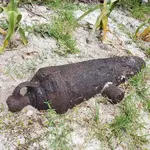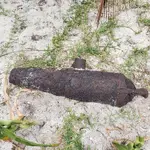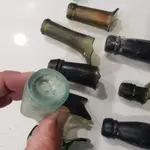Blak bart
Platinum Member
Im sure that these builders were building hulls that had been built by there fathers fathers....that design is a open hull and was most definitely ballasted. so im pretty sure that this hull design would have been widely used by the turtlelers, spongers and fisherman....they more often than not used lead bar back in the 70s when I was a kid, but they would use just about all manor of stone mixed in with the (precious and hard to come by) lead. And of coarse as a kid we all herd about old man so and so who had mistaken spanish silver bars for lead bars and used them as ballast !! As for understanding what your seeing as ballast is very important....I have had islanders bring me to there big spanish galleon wreck only to have to tell them that the grey rock with quartz banding is really just new England ballast from the northeast, and that there wreck is no more than a trading schooner from the northeast, and not the glorious spanish galleon they thought it was. These sloops from andros would calculate just how much ballast they would need according to how they would be loaded and with what . Often times they would leave lightly ballasted in anticipation of a heavy return load.....when overloaded they would jettison even more ballast to make up for the extra load. Jettisoned ballast will often be laying in a flat fan like pattern.....as the boat swings back and forth on the anchor and the ballast is thrown over it forms a particular scatter pattern. A large pile in the shape of a boat, and with wood iron, glass, etc...is more than likely a wreck. Sometimes its a trail of stones leading to a pile or multiple piles where the boat was bouncing and breaking up. Strong surf can diperse the ballast and flatten it on the bottom also. This last trip I had an audience for listening to me about ballast. At one point I asked them about a particular beach and if they had seen all the ballast there in the sand and rocks....they answered as a body and all said there must be a wreck....I said I think this was an area for loading provisions and cargo.....of course they wanted to know how I knew this. I said you have a salt pan just over the hill, and the ballast on the beach is from many different places...they were amazed that I could tell them the different places that the ballast originated. Green serpentine ballast from Cuba, grey shale and granite ballast from the northeast and Europe, and the rounded beige river rock from south and Central America that indicates the spanish main. All was scattered about the beach indicating a traditional spot of loading and unloading goods !! So....many conditions will indicate a wreck or just a spill. Its taken many years to learn all the clues and all the right factors have to come together to identify these mounds and significance. For example there is a pile I found in elutherea....spanish ballast, all in one spot, Deepwater to the east, and the ballast wedged in the reef where it had to be under full sail or in a hurricane to get that far on the reef. Add to that the fact that the stones are fused together with coral means its probably an older date range. I will look next time for jettisoned cannons on the deep edge of the reef. The lack of cannons leads me to believe they were salvaged or jettisoned on initial grounding. Only years of seeing these ballast mounds can give one the experience to extrapolate further and make the wise decision to pursue or move on. So the beige round river rock is first on my list to explore, the green serpentine ballast is next, and then the grey newengland ballast is least desirable for treasure hunting....and none of this is law or a certainty just a basic guideline.Looking at this boat: Could this be the kind of sloop that the wreckers used? I would say probably, but I am just guessing. If somebody knows better, please tell.
The shape of the hull suggests that internal ballast will be used. Again, my guess, "pebbles" from shipwrecks. These ballast stones can be dumped easily when the wrecker happens on a shipwreck with more valuable goods, like any kind of metal for example. Boats and ships carrying salt always dumped their ballast rocks at the places where they loaded the salt.
I think I read somewhere that at the harbors they had specially designated places for ballast to be dumped. At the same place ballast could also be picked up when needed.
In the Bahamas the natural rocks are limestone, that is often porous and never very dense. Dense round rocks, like basalt river or beach rocks were the preferred type of ballast.
So when do we know we have a shipwreck site or just some dumped ballast? When is a shipwreck a shipwreck?











